Tracing The Trajectory of Illustrations in Tamil Periodicals
Author
Hemavathy Guha
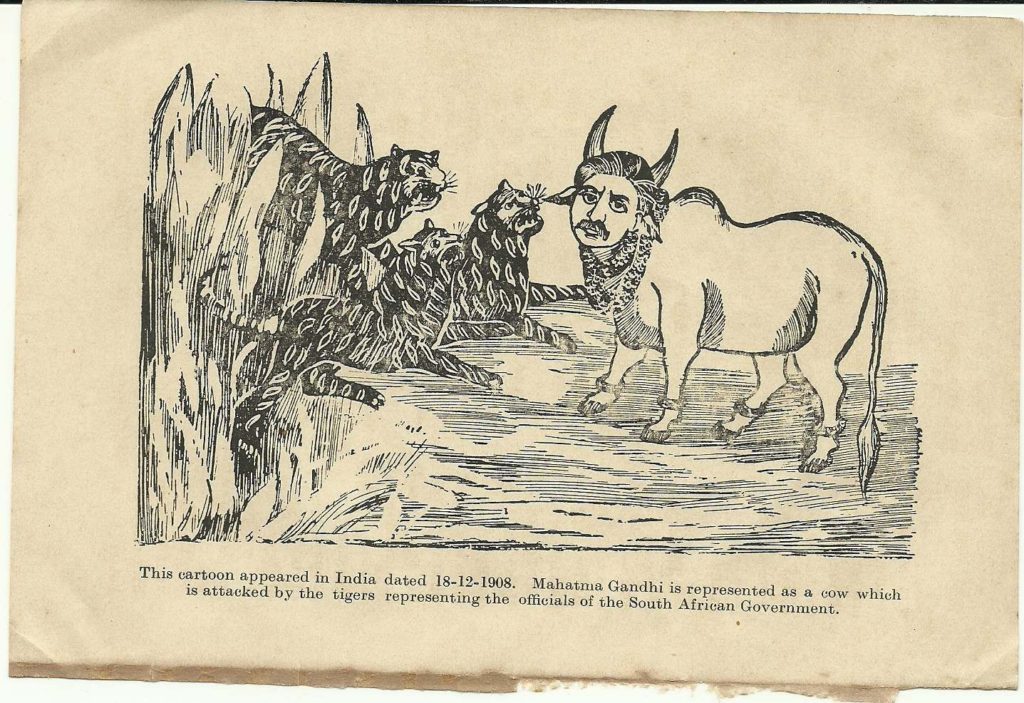
Great authors and poets have always played with various figures of speech, simile and metaphors to help the readers visualise a scene. But what are the challenges when one is writing about issues of national importance at the time for struggle for independence from the colonial empire? And when one needs to appeal to the public at large? In helping convey ideas to people easily, visuals come to the aid of writers and editors.
In India and especially in Tamilnadu, that’s how it began in early twentieth century. But to understand the whole scenario, it would do well to unravel the beginning of print journalism in Tamilnadu. Like elsewhere, the earliest printing presses were established in Tamilnadu for religious purposes, and gradually gave way to the publishing of periodicals in Tamil with general articles and news from 1831 onwards. It was the founding of the weekly Swadesamitran, which enabled print to reach out to the masses. G. Subramania Iyer, one of the founders of ‘The Hindu’ (now a leading national English-language daily), established and started publishing ‘Swadesamitran’ as a weekly in Tamil in 1882 and as a daily from 1899, with the aim to educate the ‘Tamil-speaking people in modern politics and self-government’ as described by Dr R Pricila.1 Needless to say, Swadesamitran was a highly successful newspaper in Tamil and was popular throughout Tamilnadu, and among the Tamil speaking diaspora in Burma, Ceylon, Malaysia, and Singapore. The poet Subramania Bharati’s journalistic career began at Swadesamitran as a sub-editor in 1904, but after a short period he moved on to the newly launched India as Editor. It is India that carried his fiery political articles, writings on current affairs and where he introduced compelling ‘visuals’ in the form of cartoons illustrating the political situation present then.
According to various scholars, the weekly India was the first paper to feature political cartoons. This was introduced by Bharati and at times, the entire front page carried political cartoons. The political cartoons that appeared in London-based Punch and the works of British cartoonist Sir David Low, American illustrators Norman Rockwell and Howard Pyle, and the Italian artist Matania were the inspiration for many of India’s illustrators.2 While this was the beginning of the visuals by artists in journals, it also flourished as a space for creative writing and poetry in Tamil weekly publications in the decades to come.
Serials, short stories, poems, and essays have been a part of Tamil weekly periodicals, which have been popular and widely read by Tamil speaking communities, not only in India, but elsewhere. It would be apt to mention that these magazines were popular because of the catchy illustrations drawn by different artists, besides the textual contents. Bharati introduced cartoons to emphasise his ideas, which were political at that time and from then on almost all the newspapers carried at least one cartoon in every issue. According to KRA Narasiah: ‘Bharati was the first in South India to publish cartoons in any paper, in any language.’3
During the nationalist movement, vernacular journals and papers were used extensively by editors and writers to rouse the public’s consciousness against the empire. From 1920 onwards, many Tamil language periodicals were launched, with each promoting their own objectives and principles. A common thread uniting these initiatives was the presence of illustrations enhancing the appeal of the stories and serials. In Alice in Wonderland, the protagonist rightly asks: ‘And what is the use of a book… without pictures or conversation?’
When the Tamil magazine Ananda Vikatan was launched in 1926 followed by Kalki in 1941, illustrations became a regular feature. Several artists like AK Shekar, Mali, Raju, and Verma were illustrating for Ananda Vikatan. Initially, most of the magazines had their own staff artist who drew exclusively for them. This system was broken as told by another famous artist Maniam Selven. During the 60s when the magazine industry was flourishing, the artist Jeyaraj’s youthful illustrations became very popular. He was invited by all the magazines to draw for them. This broke the system of staff artists. Thereafter artists like Ramu, Maruti, Maya, Maniam Selven and Aras started getting offers from several magazines to illustrate for them.4
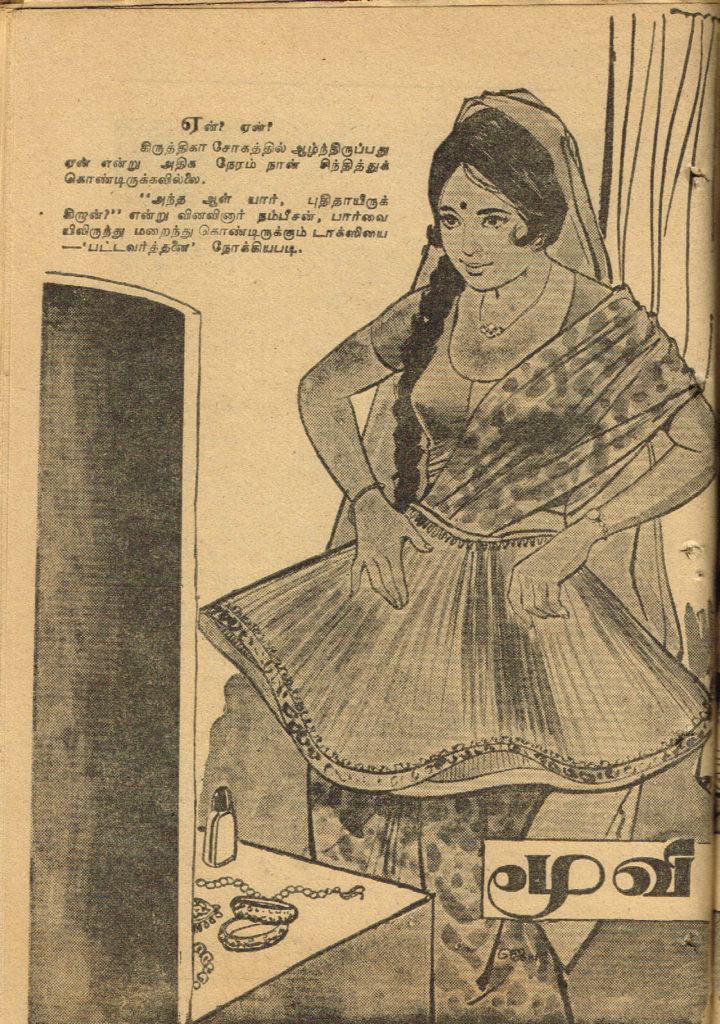
Even though they were not affiliated to any single magazine, yet each held a unique style evident at a glance. In my conversations with them, they stated that in their long career of nearly 50 – 60 years, beginning with a croquil nib, Draftsman pen, they have drawn pen and ink drawings, wash drawings, used air brush techniques, photo ink, pastels and painted in watercolour—experimenting quite a lot based on the situation’s requirement.5 Yet in their style and in the manner of handling the medium, they all have left an indelible mark in their works.
Some of the illustrators who were the pioneers in the field were K Madhavan, Simha, Maniam, Shilpi, Raju, Razak, Maya, Gopulu, R Natarajan, and Madhan. Other stalwarts who have been contributing for sufficient number of years and who are still actively creating illustrations are Jeyaraj Fernando, Ramu, Maruti, Maniam Selven, Aras, Shyam and some of the younger artists. Many of these senior artist illustrators are now of an advanced age. I must say, there has been a lack of proper research in this field and also lack of preservation of old issues of magazines. For those who are no more, I had to depend on available information and oral histories from others who had known them. It is possible some names have been left out which will be corrected whenever additional information is available.
Ananda Vikatan also hired, gave scope to, and promoted many cartoonists like Mali, Gopulu, Raju, Shilpi, Thanu, and Madhan. The cartoonist Mahalingam fondly referred as ‘Mali’ became very popular and according to Mr AR Venkatachalapathy on ‘Political cartooning in India’: ‘He did brilliant caricatures of politicians, British officials and Carnatic musicians. Mali’s unique style could be noted in these caricatures.”6
While speaking to many of the artist illustrators, it seems that artist K Madhavan was the pioneer in the field of illustrations in magazines and also painting for film banners and ads.7 But he was a freelancer and painted more for cover pages of periodicals and later on became famous as a painter of backdrops for theaters, film banners, and while excelling in making portraits.
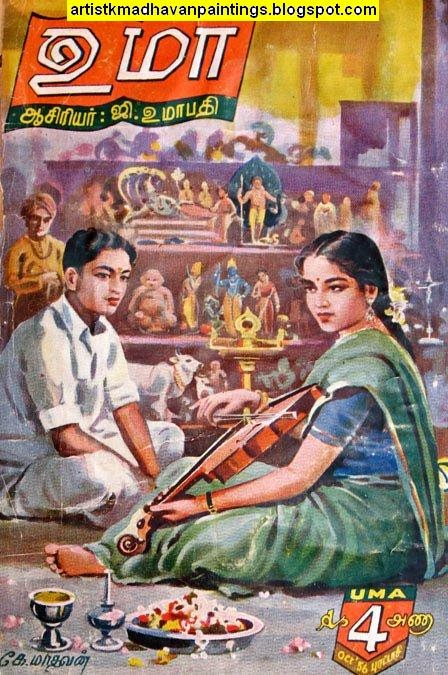
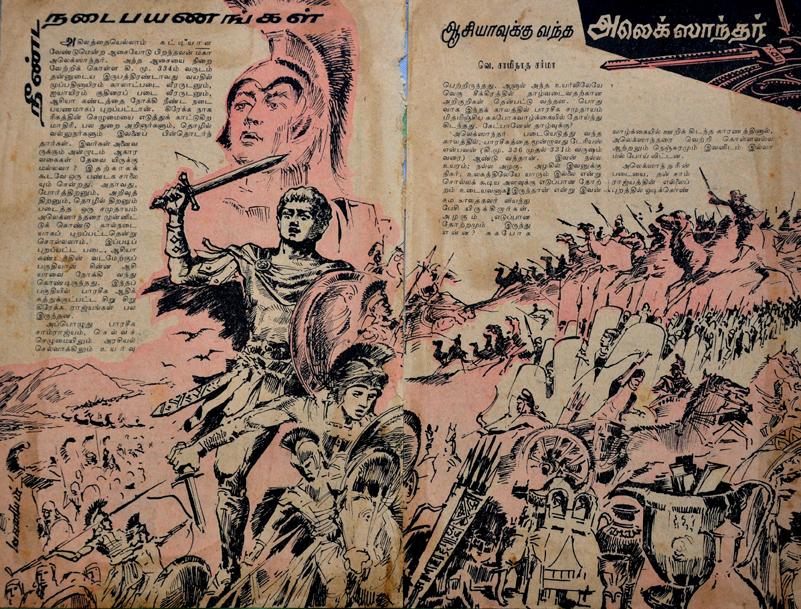
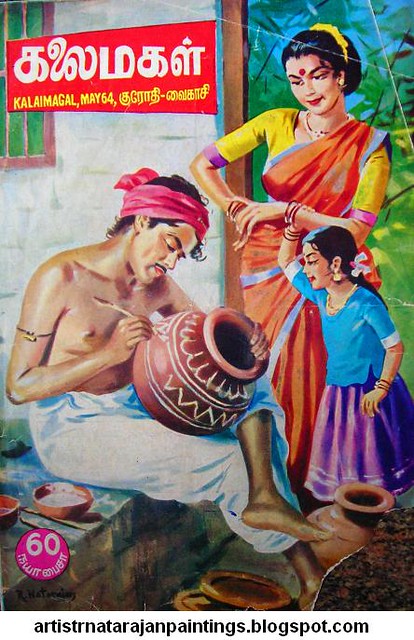
The readers identified specific artists with the writing of certain authors, and characters were visualised through the eyes of the artist. On their part, artists like Maniam who excelled in depicting historical characters and also his son Maniam Selven took great pain to draw historical characters with accuracy in style, by visiting Ajanta, Ellora, Badami, and other places, studying the sculptures to capture costumes and ornamentation.8 Even when the story demanded depicting the cockpit of a plane, Jeyaraj visited the flying club in Chennai to get the details right.9 Maniam Selven mentioned an instance where in order to authentically illustrate a poem, he visited the village where the poem was set and also studied army officers’ uniforms and equipment to draw them accurately when that was required.10 Jeyaraj recalls that he introduced new styles and fashion quotients for young boys and girls who started tying the saree in a low hip manner as he drew and also tucked the goggles in their neckline. Even the design of ladies’ handbags and the hairdos changed in Tamilnadu according to his depictions, a claim easily attested by many!11
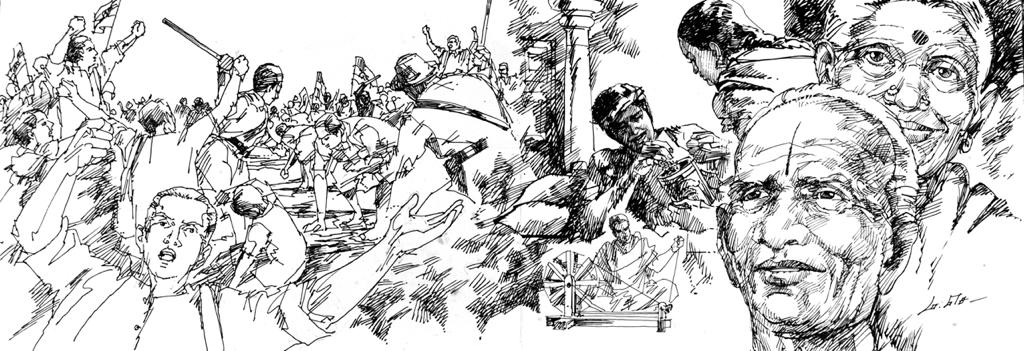
Political parties also published magazines in Tamil which served as a forum to air their views and ideologies. Notable among these were the Tamil weekly started in 1925 by EVR popularly known as Periyar, to propagate the philosophy of his self-respect movement known as ‘Kudi Arasu’. Later on M Karunanidhi, the leader of the Dravida Munnetra Kazhagam party started a journal titled Murasoli in 1942 during the second World War, when he was just eighteen years old. Karunanidhi brought out handwritten editions in the initial stages under the pen name Cheran. It is still being published as a daily from Chennai since 1960.12
It appears that artist illustrators have contributed their creations to these periodicals from time to time when they were requested, especially in the annual special issues of ‘Pongal Malar’, which contained stories, poems et al. They were not directly involved in propagating the ideas of any political party, although they have designed symbols and pamphlets and folders for them.
Apart from those artists who worked for popular magazines, there were also some such as Trotsky Marudu and Adimoolam who were illustrating for little magazines in Tamil like Kasadathapara, Pregnai and Kanaiyazhi, many a times foregoing remuneration for their illustrations. By the 80s, these artists made a foray into popular magazines and brought about a radical change in the manner of illustrations, as stated by Trotsky Marudhu.13

Despite changes in readership and writing mediums, as well as the availability of technology and digital processes, artists have held on to the art of hand drawn illustrations. They still draw and paint with their pen and ink, colours, and brushes, but some of them do enhance their creations with the aid of digital mediums. This is yet another stage in the history of illustrations in Tamil weekly periodicals.
Notes
1 R Pricila, ‘A Survey of the Press in Tamilnadu in the Early Phase of National Movement’, Academia and Society 2, No 2, 86 – 92.
2 Jeyaraj Fernando, Maniam Selven and Trotsky Marudu (artists) in conversation with the author. 2020 – 2021.
3 KRA Narasiah, ‘When a pen’s flourish led fight against British’, The Times of India, 11 September 2015, https://timesofindia.indiatimes.com/blogs/tracking-indian-communities/when-a-pens-flourish-led-fight-against-british/; see also: Narasiah, ‘Bharati as a journalist’, a lecture presentation to Tamil Heritage Foundation, http://www.subaonline.net/thf/thf_depot/narasiah/Bharati_as_a_journalist.pdf
4 Maniam Selven (artist) in telephonic conversations with the author. 2020 – 2021.
5 Jeyaraj Fernando, Maniam Selven, Maya (artists) in interviews with the author. 2020 – 2021.
6 Sreedevi Arunram, ‘Interview with A.R. Venkatachalapathy on Cartooning’, 24 July 2017, Sahepedia, https://www.sahapedia.org/ar-venkatachalapathy-cartooning
7 Maniam Selven (artist) in conversation with the author. 2021.
8 https://www.maniamselven.com/
9 Jeyaraj Fernando (artist) in an interview with the author. 2020.
10 Maniam Selven (artist) in an interview with the author. 2020.
11 Jeyaraj Fernando (artist) in an interview with the author. 2020.
12 T N Gopalan, ‘How Karunanidhi tapped into the power of newspapers with “Murasoli”’, The News Minute, 8 August 2018, https://www.thenewsminute.com/article/how-karunanidhi-tapped-power-newspapers-murasoli-86171
13 Trotsky Marudu (artist) in conversation with the author. 2021.
About the Author
Hemavathy Guha is a visual artist and writer. She holds a postgraduate degree in economics and has studied painting and printmaking (diploma in fine arts) from the College of Arts and Crafts, Chennai. As a visual artist, she has organized 18 one-woman and two-person exhibitions in different parts of India and also participated in exhibitions at All India Level. Her works have been exhibited in various international print biennales/triennales and are in the collection of National Gallery of Modern Art, The Lalit Kala Akademi and many private collections in India and abroad.
She has been contributing articles on art, architecture and travelogues for prestigious magazines like India Perspectives, Discover India, Swagat, Rashriya Sahara, The Eclectic and Creative Mind. Of late she has also contributed for online ezines, Matters of Art (India’s first ezine of contemporary art) and ArtSome. She is passionate about her research on the ‘trajectory of illustrations in Tamil periodicals’. She lives in and works from her studio in Delhi.

